Who doesn’t want to hear a good story ? Storytellers have shaped our societies and the way we think. With the dawn of times, came the stories of deeds, heroes, villains, and magic. Humans would gather together to hear stories, shared around a fire. Storytelling constructed cultural and societal bonding and developed collective consciousness and culture. It is impossible to imagine a society without a strong storytelling culture, crafted by generations of humans engaged with each other, telling stories to entertain, teach, and pass on to the younger generations old knowledge and wisdom.
Lately, storytelling has been increasingly appropriated to the advertising industry. Various important brands have experimented with innovative storytelling marketing strategies, appropriating great old-fashioned storytelling formats, mixing them with modern technology. Marketing discovers nows how stories hit us at a very primal and emotional level while technology help us engage and participate.
In 2013, Marketing Week reported that the most successful brands differentiate themselves through the use of storytelling (Bacon, 2013). Reporting on a study by OnePoll, commissioned by Aesop, Marketing Week states that the top ten storytelling brands are all very big names, well recognised in the UK marketplace. In order, they are: Apple, Cadbury, Walkers, Coca Cola, McDonald’s, Marks & Spencer, Kellogg’s, Heinz, Fairy and IKEA. The success of these firms evidences the importance of good storytelling by brands, but understanding how to emulate this is challenging facing businesses all over the world.
Some of the most engaging marketing experts advocate storytelling and have also used this effectively to build their own personal brand. Mentioning names like Seth Godin and Guy Kawasaki makes this idea easier to understand (Johnson, 2012) since these are clearly well known names in the marketing world that have achieved great successes in this area. Understanding the trends in storytelling can transform a brand, making potential customers sit up and pay attention just through the power of the words on the page. But just how is it to be done, and what are the most important trends? Among these are:
1. Engagement
The buzz word in storytelling at the current time is “engagement” and there is a good reason for that. Customers expect to be engaged by organizations. Without engaging customers businesses are likely to struggle in the current market place. This engagement with customers means understanding their wants, needs and interests to be able to create compelling stories that will really appeal to them
2. Authenticity
Customers are smart and what customers most certainly do not want is thinly veiled marketing messages dressed up as “engaging stories”. This is not engaging; it is fake. Customers will see right through it in an instant. Those brands that are really cutting edge with storytelling are able to capture a sense of the authentic. The marketing message is in there too, of course, but the authenticity of the story is the key here.
3. Revealing the unknown
Writing for Forbes, Phil Johnson (2012) explains that: “If your story does not reveal something personal and unknown about the person or brand, it’s going to be boring”. Focusing on bringing a story to life by keeping people engaged in this way is going to be necessary for businesses to draw in their customers in the longer term.
Intelligenthq: 7 top storytelling trends4. Elicit emotional responses
Julia McCoy (2014) of Social Media Today notes that content that tries to gain an emotional response will be that which is most engaging for customers. This requires a solid focus on the headline which will be the initial attraction for customers, and each word here counts. Emotions like anger can lead to people making decisions that drive their purchasing activities.
5. Use of video
Telling a story in writing is one thing, but telling it visually can be even more gripping for customers. So much more can be said in video than it can in the time that it takes to read a story. Video is on the up in storytelling, and this trend is unlikely to change any time soon. In particular younger customers are even more likely to be watching videos rather than reading stories so appealing visually will be necessary to pique the interest of this group.
6. Use of heritage
Some of the most successful brands have been focusing on both past history and the present with imagination when attempting to tell stories to drive marketing, according to Marketing Week. This has been especially true when companies have had to come back from hard times, and consistency over time is considered important in this genre of storytelling. Of course, if you don’t have much of a history, this approach could be challenging.
7. Accessible
The best marketers in the storytelling field know that stories must be out there and accessible to customers. They have mastered social media marketing and are aware of the level of contact that their customers want. They don’t overdo it, but when they post a story, whether it written prose, pictorial or a video, the timing is just right increasing the story’s accessibility to their customers.

Paula Newton is a business writer, editor and management consultant with extensive experience writing and consulting for both start-ups and long established companies. She has ten years management and leadership experience gained at BSkyB in London and Viva Travel Guides in Quito, Ecuador, giving her a depth of insight into innovation in international business. With an MBA from the University of Hull and many years of experience running her own business consultancy, Paula’s background allows her to connect with a diverse range of clients, including cutting edge technology and web-based start-ups but also multinationals in need of assistance. Paula has played a defining role in shaping organizational strategy for a wide range of different organizations, including for-profit, NGOs and charities. Paula has also served on the Board of Directors for the South American Explorers Club in Quito, Ecuador.





























